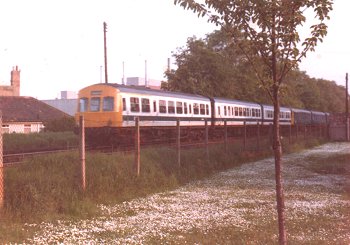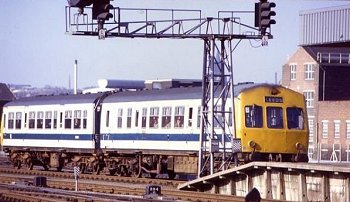Class 101 Met-Camm 2,3 & 4-car DMUs
Liveries

Green with no whiskers
Most vehicles were originally turned out in DMU Green with three cream bands, one at the bottom edge of the body, the second cutting a line through the window frames at the base of quarterlights, sweeping down at the cab front corners to form a waist height line below the cab windows. The third band was placed above window level. Whiskers were not originally carried on some of the earlier, or even distinctly later deliveries.
The image shows a power-trailer set without whiskers at Saughton Junction on the 3rd October 1959. Stuart Mackay Collection.
Some early deliveries carried the BR lion over wheel symbol, but most recieved the BR roundel (coaching crest). In both cases these would normally just be carried on power cars.

Green with whiskers
Vehicles from 50192 (and partners) were delivered with Blue Squares on the cab front. All others quickly had them added. Whisker styles could vary, depending on where they were added (at Met-Camm when new or at depots).
The image shows a fresh looking 101 with whiskers, heading for Coventry, taken at Northampton Castle. Undated, photo by Tony Pirie. Ian McDonald Collection.

Green with yellow panel, original lining
As with other units, the early '60s saw the introduction of the small yellow warning panel below the cab windows in place of the whiskers, a practical step towards greater safety. Carrying with panel is E50748 heading this 4-car set at Darlington Bank Top Station in 1964, in the north end dock where the Bishop Auckland / Crook trains, and prior to 1962 the Stainmore trains, departed from. Roy Lambeth.

Green with yellow panel, revised lining
Often when the vehicles were repainted they would recieve the darker Loco Green and 'revised' lining which would match other DMUs - one broader band at waist height and the other narrower band just above window level. Such a set is seen in York station, date unknown. Note the orange stickers on the cab and on the bodysides, this is one of the Tynerail stickered South Gosforth vehicles. Tony Wilkins.

Green with yellow first class stripe
The Scottish Region seemed to be the only ones that added the stripe to green vehicles. In this view 51528 carries the yellow stripe, and also set number 211. It has red buffer beams and is still in Multiple Unit Green with original lining. The vehicle behind has been repainted into the darker Loco Green with revised lining. Seen at Dunfermline Lower. Undated. David Mant.
Green with full yellow end, original lining
At least one vehicle, 50314 ran in green livery with a full yellow end while still carrying the original lining. A picture showing this style can be found on the RCTS image website showing 50314 on 25th November 1967.
Green with full yellow end, revised lining
At least two Scottish vehicles ran in green livery with a full yellow end with the revised style of lining.
One, a DMBS thought to be Sc51224 can be seen in this image (no date), the other was DTCL 56393 seen in an image on flickr on 26th December 1967.
Green with no lining
In the changeover era from green to blue some Scottish Region DMUs (of different types) were noted in unlined green. This image has an unlined Met-Camm DMBS in the two-car set.
Rail Blue with yellow panel

From 1967 vehicles started to appear in the newly introduced Rail Blue livery, the plain blue bodysides were greatly enhanced by the polished aluminium window frames. Some early repaints received one of two short lived variations, one having only a small yellow warning panel below the cab windows, similar in size to that carried in green. They would also have a red buffer beam and umber brown frames and bogies. The BR logo was on the cab door and smaller than usual numbering (3" not 4").
Shown in this style is set TY410 with (50331 + 59123 + 50313) on the RCTS South Midlands railtour at Higham Ferrers goods yard on 18th May 1968. Robert Chilton.
Rail Blue with yellow panel, ER style

A Class 101 seen at Whitby on the 12th April 1972. It is in blue livery with just a small yellow warning panel. John Reddyhoff.
Vehicles repainted at Doncaster Works would have a larger yellow panel, covering the lower half of the cab front. These were normally Eastern Region sets, but at least vehicle Sc51524 one was noted on the Scottish Region (see page 51 of the Brian Morrison DMU book) with this style.
Rail Blue with yellow cab doors

The second short-lived variation involved much more yellow, covering whole the cab front and the cab doors. An example in this style is seen during a layover in Newton station on the BLS 'Glasgow South Railtour' on the 29th August 1970. Stuart Rankin.

Rail Blue with full yellow end
The majority of the repaints into blue had full yellow ends. This ex-works example is E51504 at Doncaster on 2nd November 1969. David Mant.
Blue Grey (Western Region 1974)
Five three-car units were transferred from Hamilton Depot to Plymouth Laira in the week ending 25th May 1974, all in plain blue livery, becoming P800-4.
P800 and P801 paid a brief visit to Swindon Works but then entered service in plain blue livery. P802, P803 and P804 underwent overhaul at Swindon Works then entered service in June/July 1974 in Blue/Grey livery. Allocated to Cross-Country services, it allowed them to blend in with their other sets. The two plain blue units eventually went Blue/Grey during 1975.
Four of the five units (excluding P800) received a repaint in Blue/Grey and at the same time lost the cab head code boxes.
All five units went through the BR refurbishment scheme between April 1978 and January 1979, gaining the (then) standard white with blue stripe livery.
Between July 1980 and December 1981, the units went the way of other such units in the blue stripe livery and lost this in favour of Blue/Grey.
The Works / pain dates, extracted from the Works Overhaul history for each unit by Eddie Knorn, are below.
P800: 51445 - 59549 - 51515
Swindon C5 (Out of Course Works Attention) 7 June 1974. Noted shortly afterwards in service in plain blue livery. Cab head codes retained.
Swindon C3 (Repaint) 10 October 1975, painted Blue/Grey, Cab head codes retained.
Swindon C1R (Refurbishment) 7 April 1978, White with Blue Stripe livery. Cab head codes removed.
Swindon C3 (Repaint) 8 July 1980, painted Blue/Grey (again).
P801: 51446 - 59547 - 51517
Swindon C5 (Out of Course Works Attention) 20 June 1974. Retained plain blue livery. Cab head codes retained. (Similar to P800 above).
Swindon C3 (Repaint) 4 April 1975, painted Blue/Grey, Cab head codes retained.
Swindon C3 (Repaint) 28 January 1977, presumably painted Blue/Grey and Cab head codes removed. (See P802, 803 & 804 below ?)
Swindon C1R (Refurbishment) 19 January 1979, White with Blue Stripe livery
Swindon C3 (Repaint) 15 December 1981, painted Blue/Grey (again).
P802: 51449 - 59550 - 51521
Swindon C3 (Repaint) 14 June 1974, painted Blue/Grey. Cab head codes retained.
Swindon C3 (Repaint) 4 June 1976, confirmed painted Blue/Grey and Cab head codes removed.
Swindon C1R (Refurbishment) 30 June 1978, White with Blue Stripe livery
Swindon C3 (Repaint) 19 December 1980, painted Blue/Grey (again).
P803: 51450 - 59546 - 51522
Swindon C3 (Repaint) 5 June 1974, painted Blue/Grey. Cab head codes retained.
Swindon C3 (Repaint) 22 June 1976, confirmed painted Blue/Grey and Cab head codes removed.
Swindon C1R (Refurbishment) 30 October 1978, White with Blue Stripe livery
Swindon C3 (Repaint) 30 June 1981, painted Blue/Grey (again).
P804: 51452 - 59551 - 51523
Swindon C3 (Repaint) 5 July 1974, painted Blue/Grey. Cab head codes retained.
Swindon C3 (Repaint) 18 June 1976, confirmed painted Blue/Grey and Cab head codes removed.
Swindon C1R (Refurbishment) 25 August 1978, White with Blue Stripe livery
Swindon C3 (Repaint) 14 November 1980, painted Blue/Grey (again).
Refurbishment
In 1974 a class 101 3-car set (51451/59545/51518) was selected as the test bed for the refurbishment scheme. The refurbishment at Doncaster was topped off with the new refurbished livery of white with a blue stripe. The unit had different thickness stripes on each side. On the drivers side of the DMBS was a narrow stripe, the opposite was thicker 12" band which contained the BR or PTE logo. These top of these stripes ran through the door handles.



The inner ends originally had the livery carried all the way around as the first of these images show, but quickly had a blue (or black?) area added (second image - dated 12/7/74). The last picture is a production version, although this varied between works (see below "Works Repainting Anomolies").
The production refurbished vehicles adopted the 12" stripe, but this was lowered slightly, the top running along the bottom of the commode handles. The white livery was short lived, being replaced by Rail blue and grey due mainly to the problem of keeping vehicles clean in service.
Taken in 1975, Burton Lane Junction York is the location of the next photo, which was the junction of the branch to Rowntree's & Foss islands. Forming a summer extra to Scarbrough are a 3 car blue & white refurbished Class 101 & a blue 4-car Class 104. Mike Hudson.
The next image shows another refurbished liveried set, taken in the 1980s at Leeds. Graham Turner .
Some units allocated to the Western Region were actually repainted from Rail Blue into Blue and grey even prior to refurbishment with two character train describers still in situ. These units were later dealt with at Derby Works during the early 1980s.
The last vehicle to retain the refurbished white/blue stripe livery was 59121, which lost these colours for blue/grey during overhaul at Swindon works in Spring 1984, a few months short of the 10th anniversary of the livery.
Works Repainting Anomalies
Refurbished livery - Derby, Swindon & Doncaster Works gave the gangway ends a small ‘wrap-round’ with a horizontal top edge (for a good example of this see p55 of the Brian Morrison book). Those done at Glasgow had a greater wrap-round with the white following the body end contour (see the top image on page 54 of the same book).

Window frames - Glasgow also differed in painting the frames of some units in the body colour. Elsewhere, they were left shiny, although some refurbished livery sets had white surrounds, although again Glasgow differed as they painted the rubbers whereas elsewhere left them black!

Left: a close up of the picture on the right, a set which contained painted and unpainted window frames. Alan Rintoul.
Blue Grey
The first Class 101s painted into blue & grey livery were a handfull of sets transferred to the Western Region in the early 1970s.

It would be 1978 before more sets appeared in blue and grey, due to the refurbished white livery being abandoned. The height of the grey band could differ depending on the works that did the repaint. The image shows a blue/grey set circa 1981 carrying Greater Glasgow / Trans-Clyde branding. S Saunders.
Circa 1980/1 an orange line began to appear across the cab front at cantrail height (denoting a safe working area for staff under power lines).

Blue Grey with wrap round black window surrounds
At least two of Tyseley's three-car sets (TS402 and TS417) had wrap round black window surrounds, first appearing in May 1983. The image shows 53323 of set TS417 in Birmingham Moor Street on 27-5-83. On Tour With the Class 13 Army.
Strathclyde
There were two distinct adjoining periods where some vehicles were painted in an orange colour (officially 'Strathclyde Red') with a matt black band along the passenger windows. All power cars, except one which had the cab repainted after a fire, had a black 'mask' about the cab windscreens.

Period one 1984-1992
These were mostly sets in the 101 3xx series. One of the first to be treated was DMS vehicle Sc51803 (seen in the image ex-works at Tyseley carriage sidings on 22/08/84, with the Strathclyde Transport logo in the centre of the vehicle - Jerry Glover). It was initially labelled as set 101340 but would soon be running in a 107 set carrying set number 101430 (the 107 end labelled 107430).
By the mid-1980s there were four ScR based units carrying the livery. These were:
| 101 304 | Sc51224 | Sc59090 | Sc53241 |
| 101 321 | Sc51249 | Sc59542 | Sc53146 |
| 101 360 | Sc53158 | Sc59074 | Sc53160 |
| 101 363 | Sc53185 | Sc59049 | Sc53194 |

The second image shows set 101 304 seen in Glasgow Queen Street Andrew McConnell.
The vehicles were eventually dispersed to other depots, first Chester (CH) and later Longsight (LO) still sporting their Strathclyde orange and black, some now partnered by blue and grey DMBSs in the case of 53158 and 53160. Three vehicles from the table eventually made it into the Regional Railways livery in the 1990s, 51224 as part of 101679, 53160 as part of the celebrity green set 101685 and 51803 as part of 101676 (all three at LO).

Period two 1993-2003
More sets appeared in the livery when Corkerhill received a batch of facelifted 101 6xx sets. Initially some of these sets ran in England before moving north, these vehicles did not have the Strathclyde Transport logo applied at this point. The image shows 101689 (51511 + 51185) at Grantham with the 12:35 Skegness - Nottingham service on 12/2/93. Gazza Prescott.
Noticably differences between period one and period two vehicles was the black mask on the cab was not as big, and square headlamps were now fitted between the two marker lamps. There were no marker lamp variations with the 6xx sets, all only had two lower lamps.
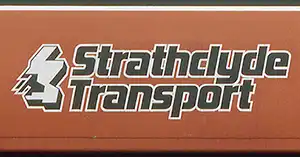
All but one set (101689) would have the Strathclyde Transport branding added to the lower bodysides in the centre of the vehicles. From circa 1995 the Scotrail 'woosh' logo began to replace the black BR arrows under the front passenger windows and a smaller version under the left cab window.
By July 1997 set 101688 had the standard Strathclyde Transport logo on the centre bodysides replaced by the new SPT Strathclyde Passenger Transport logo that had been applied to 101692.

From November 1997 they began to appear with top area of the cab front - above the orange cantrail stripe - painted black.
The image shows 101690 at Cumbernauld on 8/1/00 with the black cab top and ScotRail 'whooses'.
When Corkerhill was finished with these sets some moved to Longsight to work services in the Manchester area, they kept their same liveres — including the ScotRail and Strathclyde branding — until withdrawal.

Network South East
In 1987 the Network South East livery began to appear, initially on Cambridge (CA) sets these having red buffer beams and no black masks around the cab windows. Later treatments for London had back masks and black buffer beams.
The image shows set L835 51498 + 51432 is seen arriving at Reading West on the 17:20 Reading to Basingstoke, 29-6-93 Kevin Dowd.

Network South East with Scotrail Branding
In the early 1990s some ex-London sets were transferred to Haymarket and at least one set — 851 (DMBSs 51208 ex-L221 and 51221 ex-L207) — carried Scotrail branding. This set was also noted running with Regional Railway liveried centre car 59302.
The image shows the Scotrail branding on the side of the van on 51208 in Edinburgh Waverley on the 4th April 1994. Hamish Stevenson.

Regional Railways
In 1991 the Regional Railways livery began to appear on facelifted sets allocated to CA, NC, TS, LA, LO and HA (as already mentioned the Corkerhill units were turned out in Strathclyde colours) with new style insignia on the cab front and bodysides for PTE routes. In regional Railways liveries some units had their window frames painted silver.
The image shows ex-works 101 657 (53211 / 54085) working the 11:43 Piccadilly - New Mills at Romiley on 19/10/91. Gazza Prescott.

Regional Railways with Scotrail Branding
The four sets allocated to Scotland would have Scotrail text on the bodyside rather than Regional Railways. Two sets, 101691 and 101693, had the Scotrail branding centered under the first passenger window. The other two sets, 101692 and 101694 would have it centred between the first two windows, as seen in the image.
The image shows DMSL 53170 from set 101692 in Edinburgh Waverley with the 17:27 to Perth on 27 June 1992. Mark Grimes.
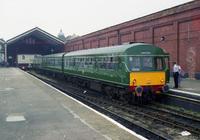
Retro Green
In June 1994 set 101685 (vehicles 53164/59539/53160) was painted in a version of the early green livery for working the Conway Valley line. It looked somewhat less than correct with a larger than original yellow warning panel, central headlight and cab front electrification warning stickers above cab window level!
The images shows the set at Llandudno ready to leave for Blaenau Ffestiniog on 1 July 1994. Stephen Burdett.

"Caledonian" Blue
Another one-off livery was Corkerhill's 101692 with vehicles 53253/53170 sporting a version of Caledonian Blue with red and yellow stripes, with full yellow cab front and black window masks. It was repainted for the inauguration of Motherwell to Cumbernauld services in May 1996 where this set normally operated.
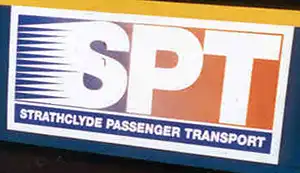
The image shows it in Glasgow Central station in April 1999. Rob Woods.
The set carried the Strathclyde Passenger Transport logo on the lower bodyside in the centre of the vehicles, and a smaller version on the cab front. The only other set to carry this logo on the bodysides was 101688.
Miscellaneous
By the end of the 1980s, many depots had begun customising their units. Red painted buffer beams appeared on some units based at Cambridge (CA), Norwich (NC), and one or two vehicles at Cardiff (CF), More widespread was the application of black cab window surrounds in the style of the Scottish sets based at ED, HA and AY. The English depots adopting the black "masks" included Tyseley (TS), which also experimented with wrap-around black cab windows extending as far as the driving cab doors. Units allocated to the London division, at RG, OC and CA also acquired black masks, though being slightly different in having square corners as opposed to the radiused variety of the other depots.
Summary
Orders
Batches
Description - Technical
Description - Interior
Description - Variations
Description - Modifications
Met-Camm Adverts
Diagrams
Drivers Instructions
Refurbishment
Numbering
Liveries
Operations - Initial
Operations - Later
Operations - Scottish Region
Accidents
Daisy - 101685
Observation Saloon 6300
Parcel Use
Departmental Use
Images
Details about preserved Class 101s can be found here.
Many thanks to Mac Winfield and Eddie Knorn for their assistance in the preparation of this section.





